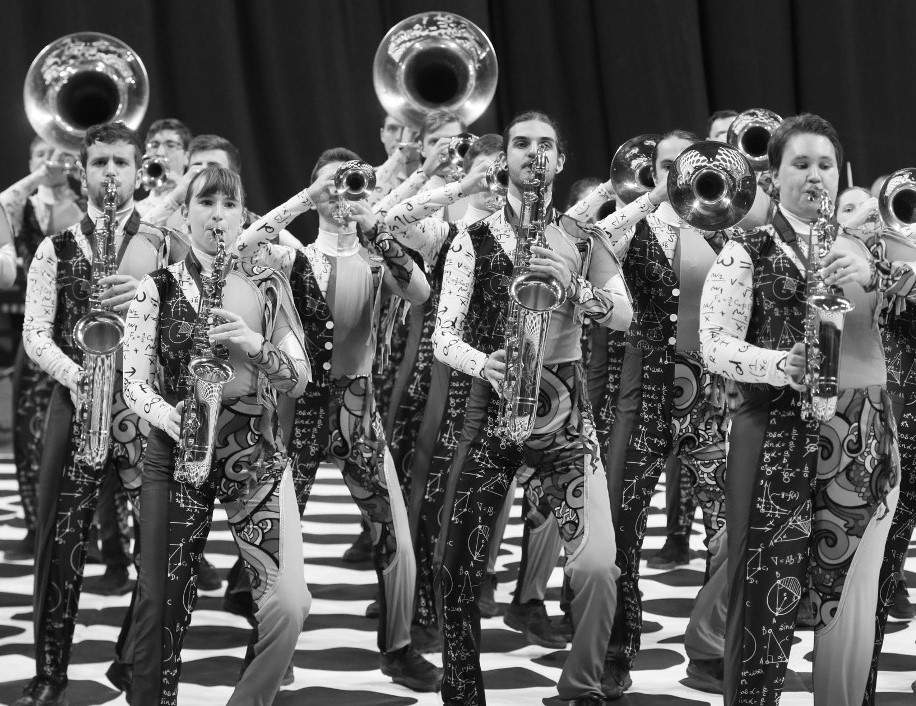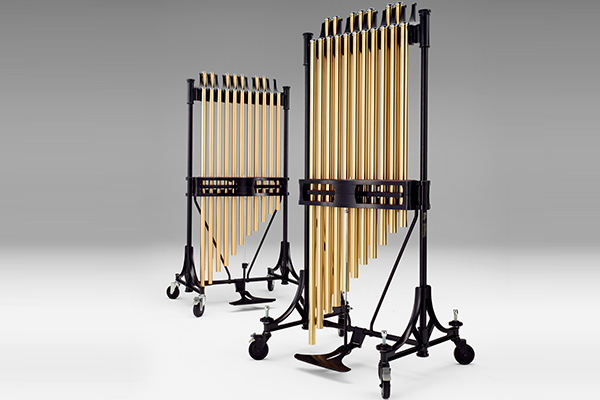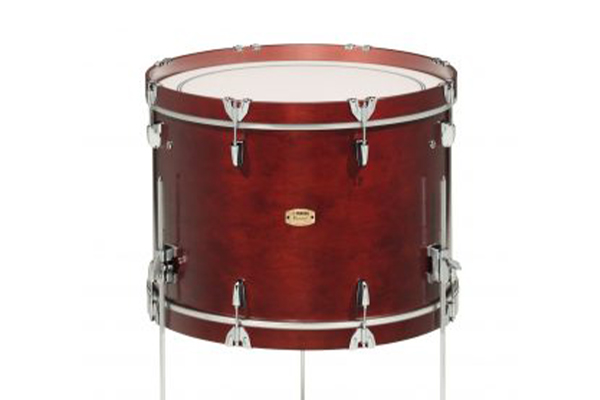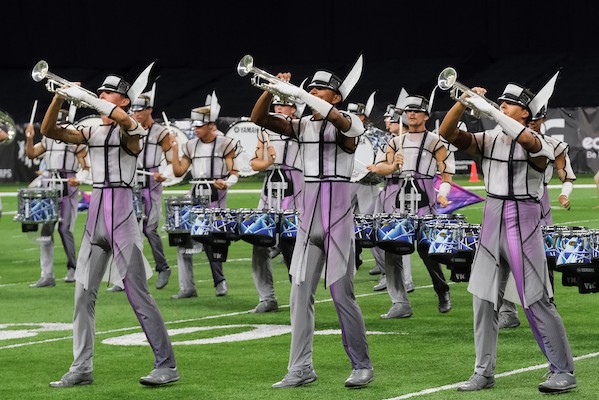Pulse Percussion and WGI Behind the Scenes
Pushing the envelope of achievement.
I remember my first Pulse Percussion clinic well. It was 2016 and I was 14 years old. Back then, I didn’t really know what I was getting myself into. I don’t remember what it was about Pulse that caught my attention, but if I had to guess, I would say it was the music composition and performance energy in the front ensemble.
I first joined the drumline at my middle school playing cymbals. I did that for one year, then quads the next. When in a moment of immaturity, I realized how much work it was going to take to play in the high school drumline, so I picked up some mallets and started learning scales and a simple solo on the marimba.
The first drum corps show I remember seeing live was the Blue Devils’ 2014 production of Felliniesque. This prompted a YouTube spree that eventually led to my official discovery of the marching arts and my eventual participation in Winter Guard International (WGI).
Here’s the story of my experience as a member of Pulse Percussion.
What Is a Percussion Ensemble?
As defined by WGI, “Percussion ensembles consist of the marching percussion (also called battery) and front ensemble (also called pit) sections of a marching band or drum corps. Indoor percussion marries elements of music performance, marching, and theater; thus, the activity is often referred to as percussion theater.”
Ensembles in WGI are classified in two ways: organization type, and skill level. Groups who compete on behalf of a school are known as “Scholastic,” while self-organized groups are “Independent.” Their skill level is designated as A Class (beginner), Open Class (intermediate) or World Class (advanced).
The Allure of Indoor Percussion
The exciting thing about participating in a marching percussion ensemble is the way groups create a movie-like environment in a high school gym by playing music unlike anything most people have ever heard.
The Pulse front ensemble offers spots on marimba, vibraphone, xylophone, glockenspiel, timpani, synthesizer and drum set. The vibraphone players usually are given melodic responsibilities and outline chordal textures, employing various types of pedaling, while the marimba players contribute faster-moving passages using a wider variety of playing techniques and stroke types. For this reason, the hierarchy of a traditional mallet percussion ensemble generally has younger members start out on vibraphone, working towards building the strength and endurance necessary to play marimba. This was my experience. I earned a vibraphone spot in 2020, practiced relentlessly to play marimba, and eventually become a section leader.
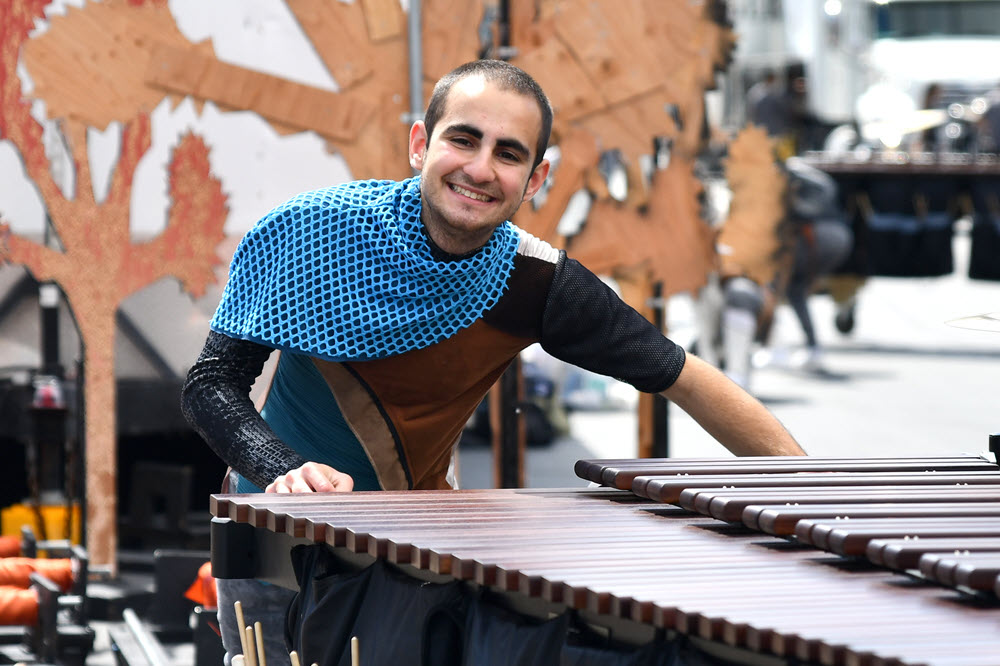
I have to admit that it can be hard to take on one of those roles. It can get awkward and even tense when you know that the people around have more experience than you do, so it definitely wasn’t all sunshine and rainbows when I first competed in 2020, but as a lot of people can agree, it’s easy to look past those things when you get handed a gold medal. If I had to give the next generation of mallet players a piece of advice, it would be this: Don’t settle, but know when it’s time to move on, and remember that everyone has a life outside of rehearsal.
My Pulse Experience
I encountered a lot of different personalities during my time with Pulse, and many have stuck with me to this day, almost as if a part of that person lives inside me. Unfortunately, in this activity, people come and go. It’s a pretty weird feeling looking around the room for your friend to crack a joke, only to realize that person aged out last season.
As with any music group, most of the work is put in before the competitive season actually starts. Some people view this as the hard part of the season, with competitions and performances as the reward. It’s easy to think this way, and quite honestly, it makes a good amount of sense, but that mindset always made me feel like I was constantly in a state of waiting for the season to actually start.
It’s odd because when I think back, the most memorable moments are those that occurred during the preseason. Whether we were spending our entire break hiding from our instructional staff to see their faces when they realized we were gone, getting threatened by neighbors to stop playing, crawling through the truck on all fours, or screaming in an attempt to match the pitch of an ongoing fire alarm, I have a wealth of shared memories to look back on.
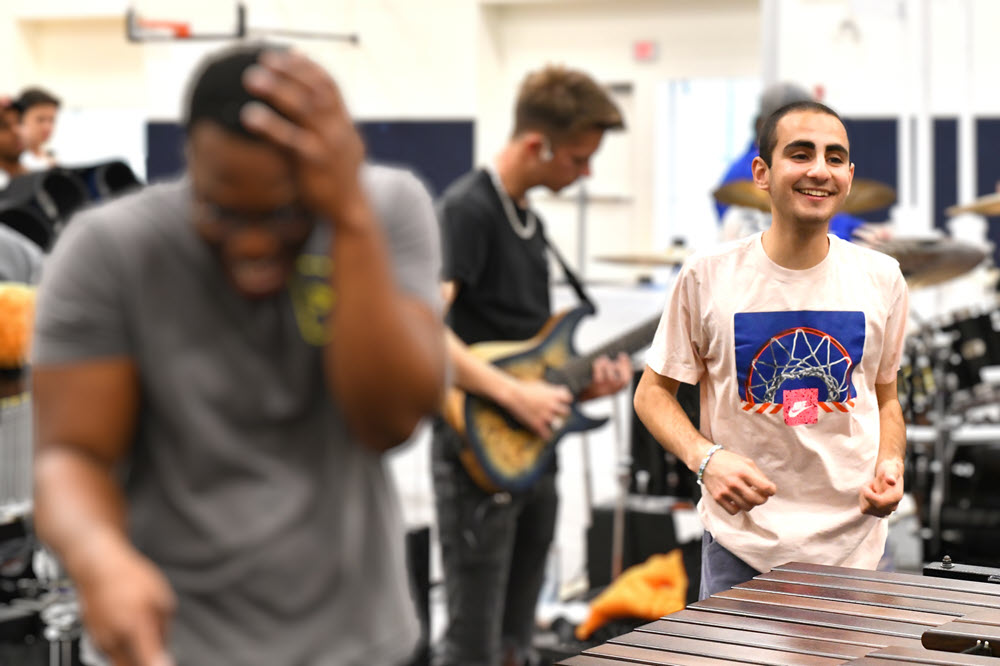
WGI Competition
During the 2023 season, in Dayton, Ohio, there was a storm on the day of the WGI semifinals competition. When it rains, you have a shortened warmup in a tent. It can get very loud and chaotic in those confined spaces, and while we did have tarps and towels, the wind made it difficult to keep everything dry until we got inside. As you can imagine, there are a lot of moving parts to our setup that really can’t get wet, including our P.A. system, which included a Yamaha TF5 digital mixer, four Yamaha DZR15 speakers and two Yamaha DXS18XLF subwoofers.
Somewhere along the way, part of the stage box that our drum set mics plug into stopped working — likely a result of the rain. Emotions were running high in the tent, but I managed to find a workaround just in time before we pushed our equipment into the arena. Times like this show why thorough planning of your electronics setup is important, and why a dedicated audio engineer is invaluable to every program. Since we spend so much time at rehearsal, observant and curious members also become well-equipped to troubleshoot.
If you were a percussionist in your high school marching band or indoor drumline, some of this might ring a bell. It can get stressful, but it’s also a ton of fun. The priority is hard work, which starts with trusting your instructional and design staff. Memorizing the music is merely step one. From there, we’re tasked with bringing the show to life. There’s a decent amount of work that goes into this, and really, it’s all about presence, confidence and flair. We shine light on every detail, whether it’s when/how we bring our mallets up and down or the vibe we aim to embody. It’s all about expression.
Audition Tips
If you don’t have access to an instrument, ask around. Past and current band directors are usually willing to let you practice on their equipment. If that doesn’t pan out, see if any of your friends or fellow auditionees can share access. If all else fails, and you’re in the financial situation to do so, search online for a local music store that rents instruments. At the end of the day, a piano/keyboard, practice pad — or even a pillow — will work.
I went the rental route at first, but once I was no longer able to afford it, one of my closest friends offered to let me borrow her personal marimba. I always tell her that I’m forever in her debt, and that one day I’m going to buy her a car. She would never let me do that, so I’ll probably just pay for her dinner a few times if she doesn’t beat me to it.
In my experience, success at these types of auditions really comes down to four things.
1. The packet
This should be memorized if you want to be taken seriously. Pay attention to dynamics, sequencing instructions and vibraphone pedaling (even if you want the marimba spot). Every detail matters. Don’t be afraid to experiment with ideas from the packet to challenge yourself and prepare for any on-the-spot variations to exercises. Depending on the caliber of the group you’re auditioning for, there may be an expectation that you’re able to play at a certain high tempo. Start slow and train for endurance.
2. Your solo excerpt
Don’t pick something cliché, and don’t pick something you know you can’t play. Remember, this is an opportunity to showcase your musicianship! A lush chorale played right is oftentimes more impressive than something super-choppy.
For reference, here’s a list of the solos I played during my marching career:
- 2020: O’Meara, Restless
- 2022: Lorick, Odessa
- 2023: Stucky, Isabelle Dances
- IV. Stomp
- 2024: Åstrand, Tribus Modis
- III. Arbitrium
Some other popular ones amongst Pulse members include:
- Mueller, The Fairview Hymns
- Sammut, Libertango
- Cangelosi, Etude in E Minor
- Marjan, Niflheim
- Monkman, Nocturnal Dance
3. Your mindset
Be mentally prepared for a long, often sweaty day. Be ready to play more than you’ve ever played before. Expect the unexpected. Sometimes you’ll be asked to play something you might not have prepared for.
4. Your attitude
Set a realistic expectation for yourself. Do not go into auditions with an ultimatum. Your ultimate goal should really just be to make the group. Talk to the veteran members and get a sense of what it’s like to be in the group. You’ll learn a lot!
In the Thick of It
Here’s what a typical rehearsal weekend for Pulse looks like:
Friday from 7:30 PM — 12 AM
Saturday from 11 AM — 10 PM
Sunday from 10 AM — 5:30 PM
If your jaw dropped while reading that, don’t worry. It’s not actually that bad, and I promise I still had a life outside of “band.”
The ensemble gets a lot better every weekend, but it only works out if everyone takes care of business during the week. My rookie year was probably the busiest time of my life; I was a full-time college student working a part-time job at a restaurant, plus I had two teaching gigs. My schedule was absolutely jam-packed, but I managed to make it work. Yes, I was tired all the time (like my fellow bandmates probably were), but it was a part of my life I wasn’t willing to give up. Some advice I would offer to anyone trying to take on a similar schedule: Don’t sacrifice your sleep.
“Pulsemas” is an exception to the normal schedule. Every year, during the holiday season, we have three or four days of back-to-back 10 AM to 10 PM rehearsals. It’s a big commitment, but it’s almost like going on a little vacation. As much work as we put in, it’s a nice break from daily life, playing awesome music and hanging out with friends. During this time, we learn our entire second movement of music and also partake in festive traditions like ugly sweaters, Secret Santa and White Elephant (this gets pretty intense), plus we put up a “Pulsemas” Tree (an artificial fir with member pictures on ornaments) and decorate our instruments with lights, garlands and ribbons.
The Culmination
As much as it seems like the whole point of Pulse is the music, or the visual aspect, or the production value, it’s really all about the people. Our design team crafts a perfect program, the instructional staff facilitates our learning, and the members define the culture and bring the show to life. The administrative staff and board of directors take care of just about everything else.
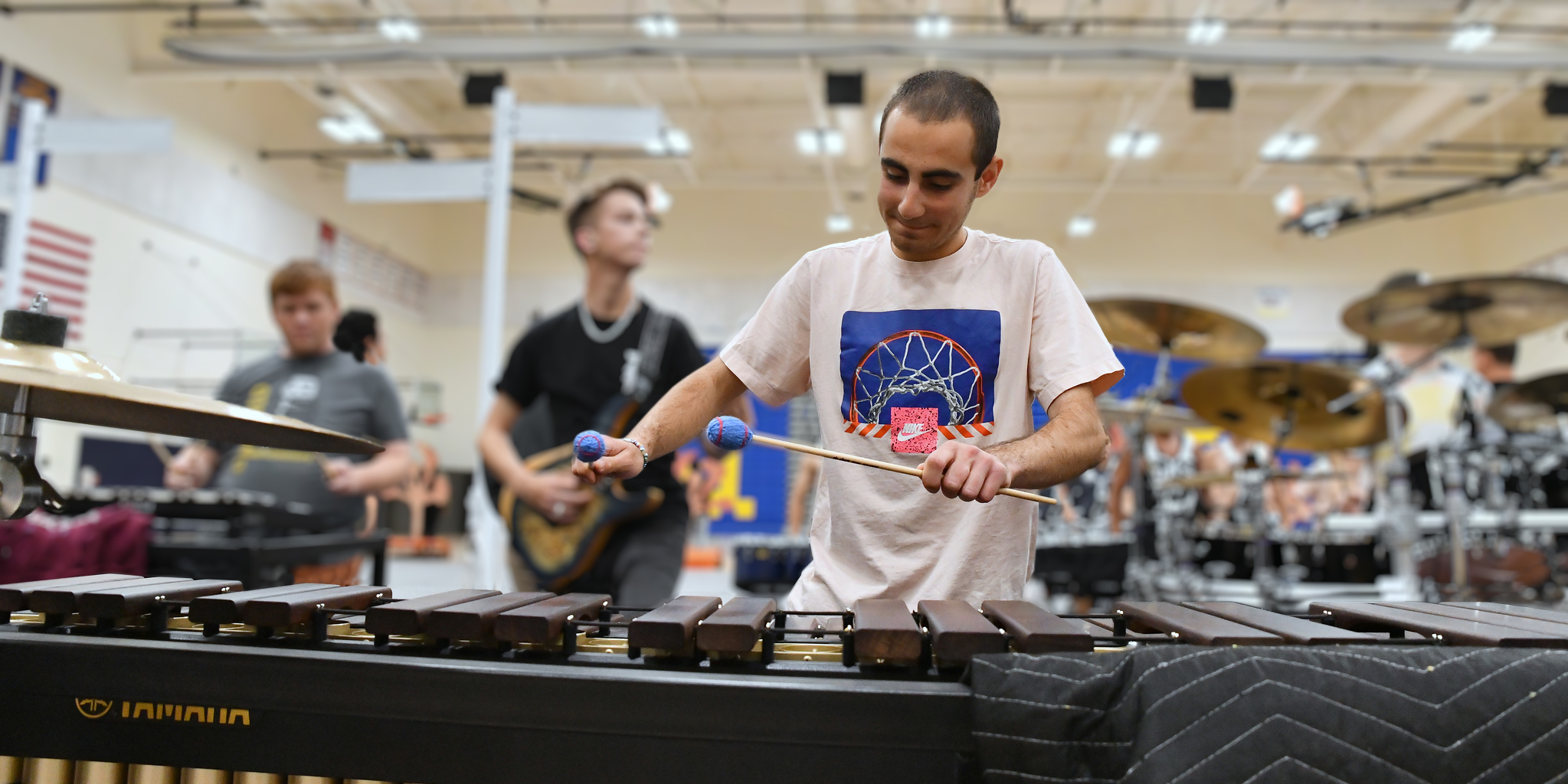
In this activity, you spend so much time with these people that you might end up closer with some of them than you are with your family. In some cases, these people become your family. As one of our staff members likes to say about Pulse, “it’s the only place where everyone around you wants the same thing.”
As much as I idolized past members of Pulse from a young age, I learned just how intimidating it can be to work closely with those who inspire or once inspired you. Impostor Syndrome (where you come to doubt your own abilities despite achieving success) is extremely common in this activity and its effects can be amplified with exposure to certain teaching styles. After idolizing “the greats” for so long, it can be a hard pill to swallow when you realize you’ve become one of them. While I don’t necessarily feel like I always fit within those bounds, I keep pushing because I know I have a responsibility to uphold, inspiring future generations of percussionists and pushing the envelope of achievement.










